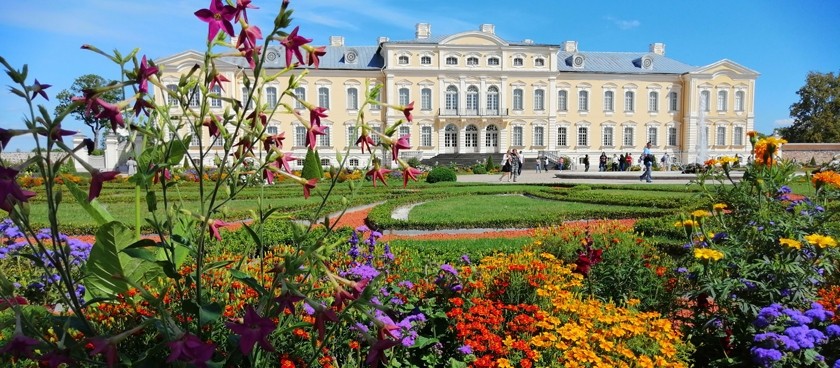
- #LV08
- Pilsrundāle, Rundāle Parish, LV-3921, Latvia
- +37163962274
- booking@rundale.net
- http://rundale.net/
- Working hours*:
May & October
Museum, French garden 10:00 – 18:00
June - September
Museum 10:00 – 18:00
French garden 10:00 - 19:00
November - April
Museum 10:00 - 17:00 - Prices*:
Combined ticket (Long Route and French garden)
Adults - 13€
Pupils - 4,5€
Combined ticket (Short Route and French garden)
Adult - 11€
Pupils - 3,5€
French garden
Adult - 4€
Pupils - 2€ - * - opening and closing times as well as entrance prices, are subject to alterations without notice. Visitors are advised to check before visiting.
- 56.4134450, 24.0244480 Copy to clipboard Copy
-
#Castles , #Family time , #Parks
History
After the agrarian reform of the Republic of Latvia in 1924, the Board of Monuments included the Rundāle Palace into the list of objects protected by the state. The restoration plans of the palace were begun in 1932, when it came under the authority of the Ministry of Education. In 1938, after the transfer of school premises to the western block, the halls of the palace and its central part came under the management of the Museum of National History. An exposition of sacred art in the palace was planned, and appropriate exhibits were collected. Subsequently, some of them came to the collection of the Rundāle Palace Museum and became the basis for one of the most important areas of the museum activity. The museum was still open to visitors during the Second World War. After the war the palace was turned into a grain collection point and the museum was not restored. In 1959, permission was granted to create a small exposition of the Bauska Museum of Regional Studies and Art in the palace.
In 1964 the Rundāle Palace became a branch of the Bauska Museum of Regional Studies and Art, and intensive research and creation of collections began. In 1972, an independent Rundāle Palace Museum was established; the restoration of the palace and the renovation of the interior began. The first director of Rundāle Palace Museum was Laimonis Liepa, his successor from 31 December until 2018 was Imants Lancmanis. In 2019 Laura Lūse was appointed as the director of Rundāle Palace Museum.
Museum nowadays
The mission of the Rundāle Palace Museum is to educate the public on various issues of architecture, art, history of culture and gardening, creating the Rundāle Palace ensemble as an internationally important centre for arts, cultural history and gardens, maintaining the repository of ancient Latvian art history, creating permanent exposition of European decorative and sacred art.
The museum
1. Restores and maintains the Rundāle Palace ensemble as a united 18th century architectural and monumental decorative art monument, improving and complementing the exposition of the interior with high-quality art works of the 18th century;
2. Cultivates and maintains the largest historical garden with a rosary in the Baltics;
5. Creates and maintains the exposition of the family vault of the dukes of Courland in Jelgava Palace;
6. Complements the museum’s scientific archive on Latvian architectural and artistic monuments, materials on the architecture of the oldest time in the history of art in Latvia, fine arts and crafts, provides access to the archive for researchers;
7. Ensures access to the permanent expositions and creation of exhibitions, as well as organization of educational events;
8. Prepares informative and scientific publications;
9. Provides advice and assistance in restoration and other issues for managers of other cultural monuments;
10. Creates an informative database about the collection of the museum for the Joint Catalogue of the National Holdings of Museums;
11. Develops and implements projects in accordance with the purpose of the museum activities;
12. Participates in the implementation of international projects;
13. Ensures publicity of museum events;
14. Examines the public demand for museum services and analyses the quality of the service provided by the museum;
15. Trains guides and organizes guide services.
Rose Garden
The rose garden of Rundāle palace is located on both sides of the ornamental parterre, filling up the areas designed by architect Francesco Rastrelli. Roses were not planted there during the 18th century.
The largest part of the rose garden is taken up by modern roses, which have been grouped by colours, in order for it to be possible to compare the work of various breeders in the formation of a single colour variation. The area closest to the parterre is planted with English roses that resemble old garden roses. There are 52 rose circles dedicated to separate breeders or countries – in them varieties created by 72 breeders from 17 countries can be viewed. Collections of historical roses have been created in the six furthermost beds of the garden. There are rose hedges formed along the eastern and western walls of the garden.
The Rose garden project was started in 2005 and was financially supported by “Latvijas Mobilais Telefons”. The garden was created with a significant help from the Latvian Army and many volunteers.
In total, there are 2230 rose varieties including 600 historical varieties grown in the garden of Rundāle Palace. Although most of the historical varieties only bloom once from late May until mid July, the modern varieties, on the other hand, can flower repeatedly until the first frost. The rose gardens displaying the diversity of species through their forms and hybrids are also very interesting in autumn when visitors are captivated by a variety of colours and forms of rose hips.